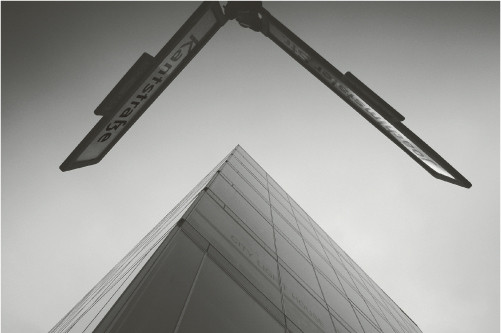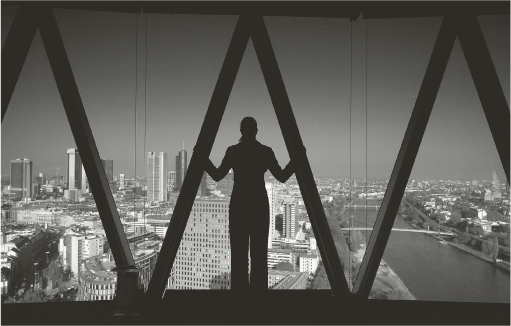8 Architectural Photography
The term architectural photography is often associated with those somewhat sterile photographs taken on behalf of a client for the simple purpose of showing architecture in the way the architect intended. This kind of photography is still taken nowadays with a professional (large-format) camera. A large-format camera allows the position of the film and optical planes to be adjusted relative to one another in order to correct architectural perspective in all focal lengths. Everything must be perfect in such photos: There should be no distracting elements like big cars to divert attention from the buildings, the light must be succinct, and the sky interesting. Frequently, architectural photos are taken in the “magical hour” (especially for color photography) when exterior light mixes with interior light.
Increasingly, architectural photography was made feasible with medium-format cameras and good shift lenses, but the digital method with a good back, or even a full-format camera with a small-format sensor, has become the norm. Photoshop now offers options for correcting distorted architectural lines.
Looking at artistic photography, there are very few big names that are associated particularly with architecture. One of them is the photographer Reinhart Wolf. He was made famous by his marvelously atmospheric photographs of New York’s skyscrapers, taken from all perspectives and in magical light. The enormous structures don’t look cold; instead the viewer gets the feeling that the buildings have a soul.
Another of his projects was to photograph industrial buildings in Berlin in such a way that the viewer could almost recognize faces in them. Reinhart Wolf is one of the very few artistic photographers that lovingly presented individual buildings in his photographs. It is typical for professional architectural photography to exclude the personalized, abstract view most of the time; Wolf’s inclusion of that view is what has made his photographs so original.
The most famous photographers who specialize in architecture are Bernd and Hilla Becher. They are at the opposite ends of the spectrum from Reinhart Wolf, who tried to intensify his buildings to the mystical plane through magical light. The Bechers, on the other hand, photograph their buildings—whether industrial plants, water towers, or ruins—as neutrally as possible. It is their philosophy to let the object speak for itself, to be as uninfluenced as possible by extreme lighting or perspective. They work only under gray skies and try to photograph every building from a middle viewpoint. Yet their photos do have a mood. The two founded the Becher School in Düsseldorf, from which three of the world’s most successful photographers graduated: Thomas Ruff, Thomas Struth, and Andreas Gursky. Thomas Struth also took some rather impressive black and white architectural photos in Naples, yet it would be wrong to categorize him as an architectural photographer.
Naturally, many other photographers take urban photos. Andreas Feininger’s and Berenice Abbott’s frequently shown photos of New York are certainly some of the best-known examples.
As in landscape photography, a rather critical approach has become the norm in contemporary architectural photography. I have already mentioned Hans Christian Schink’s images of concrete architecture. In his often shown series, Neon Tigers, Peter Bialobrzeski shows the faceless architecture of giant new buildings under neon light in Asia’s exploding metropolises.
Yet another approach to representing architecture is seen in the works of Harald Mante, who loves to create abstract images from the architecture of southern European countries. For example, he makes the Greek walls, windows, and roof overhangs look like abstract pictures. However, the thought of using architecture as an abstract interplay of shapes is not new. As early as the turn of the twentieth century, the Russian photographer Alexander Rodtschenko turned the world on its head, so to speak. Like Russian constructivism, he used architectural lines abstractly to emphasize the line interplay of oblique lines and shapes; the shape and not the content was clearly the dominant element in his representations. After the Russian Revolution, dynamism became part of the new expression, and this expression of dynamism and faith in progress is reflected in Mante’s architectural photos of the ultramodern buildings of the era.
How can you, as a photographer without a large-format camera, approach the subject of architecture in a lively way?
Photographing Architecture Digitally
A large facility management company commissioned the digital photograph in figure 8–1 for their office decor. The 21.1 megapixel resolution obtained with the full-format sensor of the Canon EOS 5D Mark II allows the photo to be printed to a width of almost 70 inches without the naked eye perceiving the pixels. Naturally, pixels can be calculated even smaller through Photoshop’s image size function (which works rather well) if the size is not exaggerated. Even at this size, sharpness is still amazing and can be compared to the resolution obtained with an analog 4.5 × 6 medium-format camera. The photo was taken with a 17 mm wide-angle lens, which can almost capture (much like a fisheye lens) the entire roundness of the Omega House building complex in Offenbach in one picture. The bare tree has a powerful graphic effect because it is an organic counterweight to the architecture. The trunk is located at the left perpendicular dividing line and subdivides the image. The image was converted to black and white using the Photoshop Black & White adjustment tool and the shadows were slightly brightened with the Shadow/Highlight tool. In such a photograph, a shift lens is not needed because distortion is an intended element of the design.
Man and Modern Architecture
The photo in figure 8–2 is quite different from the previous one. Here, a shift lens was needed to prevent the Frankfurt Tower and its reflection from appearing to fall over.
To liberate modern architectural photos from appearing sterile, you must apply several photographic principles. What makes this photo so interesting is that it mixes different planes to the point of almost penetrating each other. The various reflections within the architecture of the Frankfurt Fair Grounds create this composition. Particularly important to the composition are the architectural beams, however, because they give the photo its varied abstract structure. Another feature that makes the photo interesting is that the three persons are located on different planes. The people are silhouetted; they are shadowed figures who appear almost overpowered by the modern architectural backdrop, even to the point of looking unimportant. The fair tower is surely one of the prettiest skyscrapers in Frankfurt as it majestically projects into the sky. However, in contrast to such architecture, people appear smaller and seem to lose their importance. The next and subsequent photos prove that good architectural photographs can be taken without using shift lenses.
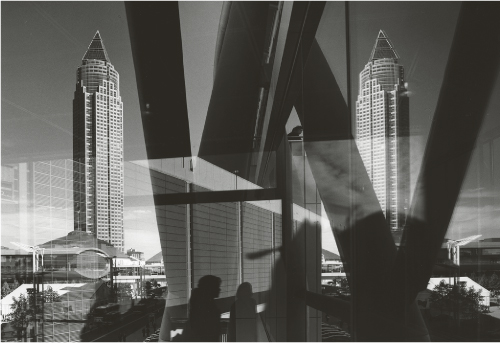
Concentrated Effect with Telephoto Lenses
Both previous photos were taken with wide-angle lenses. These lenses created a powerful architectural effect, but telephoto lenses would create the opposite effect in architectural photography. The next two photos represent architecture’s static side. Using a 100 mm telephoto lens generally results in the straight alignment of buildings, which makes it an alternative to the pricey shift lens. Naturally, the degree of distortion in a telephoto lens depends on the angle of the camera in relation to the building. In the photo in figure 8–3, the focal length was 280 mm. With such a long focal length, almost all the lines appear parallel. The picture shows the graphically interesting interlacing of two fire escapes in a modern office building. The composition is a photographic architectural abstraction. The picture was digitally photographed and converted using the Photoshop Black & White adjustment tool. The Shadow/Highlight tool brightened the shadows a little bit.
The composition has a symmetrical axis: Two steel supports run through the vertical center and reflect both spiral staircases. The risk in such a composition is that it can often appear stiff, but this photo overcomes this problem by showing two differently sized spiral staircases. Apart from its axial symmetry, the photo comes alive from its pictorial rhythm: The arched shape of the spiral staircase is repeated five times, thus creating this rhythm. The rectangle in the lower part of the image provides a counter-weight to the arched shapes of the staircases.
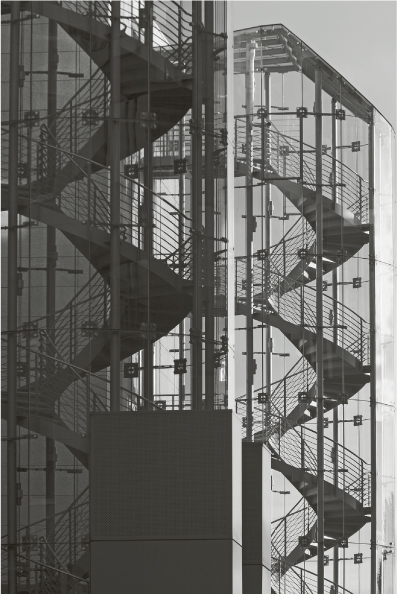
The second photo (figure 8–4) gives the impression that the buildings are very close to one other. The 200 mm lens not only causes this effect, but also does not create any falling lines in the image. This photo shows an interesting graphic interaction of horizontal and vertical lines of two modern buildings in New York with old, ornate houses embedded between them. This photo’s abstract composition rests on an exciting graphic web of light and shadow, bright and dark surfaces, perpendicular and horizontal lines, and a few playful organic forms. It shows that architectural photography is not necessarily slick and cold.
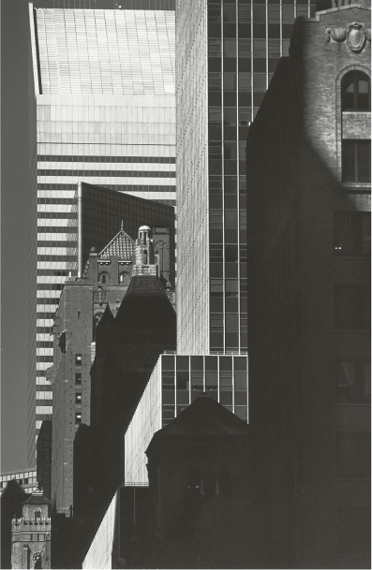
Modern Glass Architecture
Modern architecture is often very clearly and simply structured and comes to life from the transparency of its large-scale glass construction. And yet, how do you photograph a building that does not have any ornate or strong graphic structure (figure 8–5)? A shift lens would be lethal here because the distortions created by an extremely wide-angle lens would create especially interesting effects. However, the building by itself on such a gray day would not have been interesting enough. When I photographed the building, I could not use the interior lighting, so it made sense to me to add a second element: The angle formed by the street sign perfectly imitates the lines of this building in Berlin’s downtown scene. The sign symbolically encompasses the building and is a graphic element that also contains a strong black tone, thereby creating the proper countertension to the rather gray building, which helps create an interesting photo in spite of the boring weather conditions. It was also very important to use a gradient filter to gradually darken the upper part of the sky. This compositional aid also adds tension to this photo. The digital photograph was converted to black and white using the Photoshop Black & White adjustment tool. If you don’t have a gradient filter, the effect can still be created with Photoshop; however, a photo taken with a real gradient filter generally looks more natural than when you add a gradual darkening later.
Using a Model to Strengthen the Composition
A large project development company that designed the new Western Port Tower in Frankfurt commissioned this photo (figure 8–6). The view from this interesting structure was grandiose, so it made sense to enhance the view using all available compositional aids. A model serves as an identification figure for the viewer, following in the footsteps of German romantic painter Caspar David Friedrich, who often did just that (see, for example, his Wanderer Above the Sea of Fog). A human standing in front of the wide expanse of a landscape or an urban setting invites you to identify with him or her, especially if the figure’s back is turned to you or if the figure is reduced to a silhouette. A suitable and strict axial symmetry contributes greatly to the photo’s sacred expression. The woman becomes the vertical symmetrical axis, from which the window triangles are perfectly mirrored. The gradient filter used here darkens the sky appropriately and provides a good contrast to the city’s architecture that is illuminated by the sun. Frankfurt is a fascinating city for black and white photography because its numerous modern office buildings provide fascinating contrasts and design structures.
This photo was also shot digitally and converted using the Photoshop Black & White tool.


